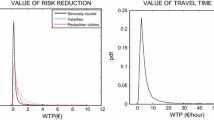Abstract
How can willingness-to-pay-based values of safety for public transport modes, such as London's Underground railway system, be expected to relate to the corresponding value for road safety? This article reports results which suggest that such values should be set at a substantial premium in relation to their roads counterpart. However, this premium appears to derive entirely from considerations of control, voluntariness, and responsibility, and, contrary to popular wisdom, apparently owesnothing whatsoever to the possibility of large-scale “catastrophic” accidents on modes such as the Underground.
Similar content being viewed by others
References
Aitchison, J. and J.A.C. Brown. (1963).The Lognormal Distribution. Cambridge, UK: Cambridge University Press.
Appleton, B. (1992).Appleton Inquiry Report. London: HMSO.
Cooksey, A. (1992).A Report of the Collision that Occurred on 8th January 1991 at Cannon Street Station. London: HMSO.
Cummings, R.G., D.S. Brookshire, and W.D. Schulze. (1986).Valuing Environmental Goods: An Assessment of the Contingent Valuation Method. Totowa, N.J.: Rowman and Allanheld.
Dalvi, M.Q. (1988).The Value of Life and Safety: A Search for a Consensus Estimate. London: Department of Transport.
Department of Transport. (1994).Highways Economics Note No. 1. London: Department of Transport.
Fennell, D. (1988).Investigation into the King's Cross Underground Fire. London: HMSO.
Health and Safety Executive. (1989).Quantified Risk Assessment: Its Input to Decision Making. London: HMSO.
Hidden, A. (1989).Investigation into the Clapham Junction Railway Accident. London: HMSO.
HM Treasury. (1991).Economic Appraisal in Central Government. A Technical Guide for Government Departments. London: HMSO.
Hope, R. (1992). “Rational Spending on Safety Brings Results,”Railway Gazette International (May), 345–349.
Jones-Lee, M.W. (1989).The Economics of Safety and Physical Risk. Oxford: Basil Blackwell.
Jones-Lee, M.W. (1990). “The Value of Transport Safety,”Oxford Review of Economic Policy 6, 39–60.
Jones-Lee, M.W., and G. Loonies (1994). “Towards a Willingness-to-Pay Based Value of Underground Safety,”Journal of Transport Economics and Policy 28, 83–98.
Jones-Lee, M.W., G. Loomes, and P.R. Philips. (1995). “Valuing the Prevention of Non-Fatal Road Injuries: Contingent Valuation vs Standard Gambles,”Oxford Economic Papers, 47, 676–695.
Kunreuther, H., R. Hogarth, and J. Mezaros. (1992). “Insurer Ambiguity and Market Failure.” Working Paper 91-12-02, Wharton Risk and Decision Processes Center.
London Underground Limited. (1991).London Underground Company Plan. London: London Underground Limited.
McDaniels, T.L., M.S. Kamlet, and G.W. Fischer. (1992). “Risk Perception and the Value of Safety,”Risk Analysis 12, 495–503.
Mendeloff, J., and R.M. Kaplan. (1990). “Are Twenty-fold Differences in “Lifesaving”f Costs Justified?: A Psychometric Study of the Relative Value Placed on Preventing Deaths from Programs Addressing Different Hazards.” In L.A. Cox, Jr. and D.F. Ricci (eds.),New Risks. New York, Plenum Press.
Miller, T.R., K.A. Reinert, and B.E. Whiting. (1984).Alternative Approaches to Accident Cost Concepts: State of the Art. Report Prepared for the Federal Highway Administration, U.S. Department of Commerce. Washington DC: Granville Corporation.
Savage, I. (1993). “An Empirical Investigation into the Effect of Psychological Perceptions on the Willingness-to-pay to Reduce Risk,”Journal of Risk and Uncertainty 6, 75–90.
Slovic, P., B. Fischhoff, and S. Lichtenstein. (1981). “Perceived Risk: Psychological Factors and Social Implications. ” In F. Warner (ed.),The Assessment and Perception of Risk. Proceedings of the Royal Statistical Society 376. London: The Royal Statistical Society, pp. 17–34.
Thomas, K. (1981). “Comparative Risk Perception: How the Public Perceives the Risks and Benefits of Energy Systems.” In F. Warner (ed.),The Assessment and Perception of Risk, Proceedings of the Royal Statistical Society 376. London: The Royal Statistical Society, 35–50.
U.S. Department of Transportation, Federal Aviation Administration. (1995).Treatment of the Values of Life and Injury in Economic Analysis. APO Bulletin APO-95-1. Washington: Federal Aviation Administration.
Viollette, D.M., and L.G. Chestnut. (1983).Valuing Reductions in Risk: A Review of Empirical Estimates. Report to the Economic Analysis Division, U.S. Environmental Protection Agency. Boulder, CO: Energy and Resource Consultants Inc.
Viscusi, W.K. (1993). “The Value of Risks to Life and Health,”Journal of Economic Literature 31, 1912–1946.
Viscusi, W.K., W.A. Magat, and J. Huber. (1991). “Pricing Environmental Health Risks: Survey Assessments of Risk-Risk and Risk-Dollar Tradeoffs for Chronic Bronchitis.”Journal of Environmental Economics and Management 21, 32–51.
Author information
Authors and Affiliations
Rights and permissions
About this article
Cite this article
Jones-Lee, M.W., Loomes, G. Scale and context effects in the valuation of transport safety. J Risk Uncertainty 11, 183–203 (1995). https://doi.org/10.1007/BF01207785
Issue Date:
DOI: https://doi.org/10.1007/BF01207785




